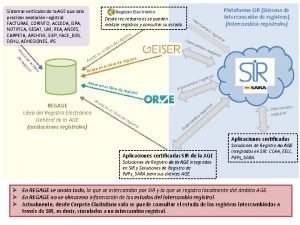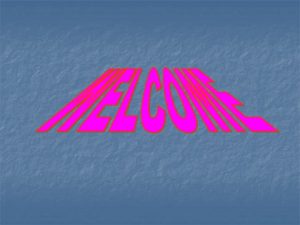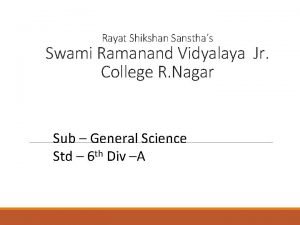RAYAT SHIKSHAN SANSTHAS KANYA VIDYALAYA DEHU PPT ON













- Slides: 13

RAYAT SHIKSHAN SANSTHA’S KANYA VIDYALAYA DEHU PPT ON: EXCRETORY SYSTEM BY: Dhamane. S. V. STD : 10 TH

Excretion Many organisms get rid of gaseous wastes generated during photosynthesis or respiration. Other metabolic activities generate nitrogenous materials which need to be removed. The Biological process involved in the removal of these harmful metabolic wastes from the body is called Excretion.

Excretion in Human Beings

Component Organs The excretory system of Human Beings includes : 1. A pair of Kidneys 2. A pair of Ureters 3. Urinary Bladder 4. Urethra

Kidneys are located in the abdomen, one on either side of the backbone. The Kidney’s primary function is the elimination of waste from the bloodstream by production of urine. Kidney can do this all only with the help of Nephrons, the basic filtration unit in the kidney. There are over 1 million nephrons in each kidney. The kidneys filter needed material and waste, the needed materials go back into the blood and unneeded materials becomes urine and is gotten rid of.

Ureter The ureters are muscular ducts that propel urine from kidneys to the urinary bladder. In the human adult, the ureters are usually 2 -30 cm long. In humans, the ureters arise from the renal pelvis on the medial aspect of each kidney before descending towards the bladder on the front of the psoas major muscle. The back flow of urine is prevented by valves known as ureterovesical valves.

Urinary Bladder is the organ that collects urine excreted by kidneys to disposal by urination. It is hollow muscular and distensible organ, and sits on the pelvic floor. Urine enters the bladder via the ureter and exits via urethra. In human male’s, the base of the bladder lies between the rectum and the pubic symphysis. In females, the bladder sits inferior to the uterus and interior to the vagina. In infants and young children, the urinary bladder is in the abdomen even when empty.

Urethra In anatomy, urethra is a tube which connects the urinary bladder to the outside of the body. In humans, the urethra has an excretory function in both genders to pass.

KIDNE Y NEPHRO N EXCRETOR Y SYSTEM

How is Urine produced?

The purpose of making Urine is to filter out waste products from the body. Nitrogenous waste such as urea or uric acid are removed from the blood in the kidneys. So the basic filtration unit in the kidneys is a cluster of very thin-walled blood capillaries. Each capillary cluster in the kidney is associated with the cup-shaped end of a tube that collects the filtered urine. These capillary clusters are called nephrons.

Each kidney has large number of these filtration units, Nephrons, packed close together. Some substances in the initial filtrate, such as glucose, amino acids, salts and a major amount of water, are selectively re-absorbed as the urine flows along the tube. The amount of water re-absorbed depends on how much excess water there is in the body, and on how much of dissolved waste there is to be excreted.

The urine forming in each kidney eventually enters the long tube, the ureter, which connects the kidney with the urinary bladder. Urine is stored in the urinary bladder until the pressure of the expanded bladder leads to the urge to pass it out through the urethra. The bladder is muscular, so it is under nervous control. As a result, we usually controls the urge to urinate.
 Rayat shikshan sanstha sadhana vidyalaya hadapsar
Rayat shikshan sanstha sadhana vidyalaya hadapsar Sadhana vidyalaya hadapsar
Sadhana vidyalaya hadapsar Rayat shikshan sanstha sadhana vidyalaya hadapsar
Rayat shikshan sanstha sadhana vidyalaya hadapsar Sant tukaram vidyalaya dehu
Sant tukaram vidyalaya dehu Rayat shikshan sanstha kamothe
Rayat shikshan sanstha kamothe Rayat shikshan sanstha loni
Rayat shikshan sanstha loni Rayat shikshan sanstha motto is
Rayat shikshan sanstha motto is Rose rayat shikshan sanstha
Rose rayat shikshan sanstha Apollonius theorem
Apollonius theorem Rayat shikshan sanstha motto
Rayat shikshan sanstha motto Sadhana kanya vidyalaya hadapsar
Sadhana kanya vidyalaya hadapsar Andes.redsara.es
Andes.redsara.es उद्दीपकाचे
उद्दीपकाचे Kanya mahavidyalaya kharkhoda
Kanya mahavidyalaya kharkhoda
























